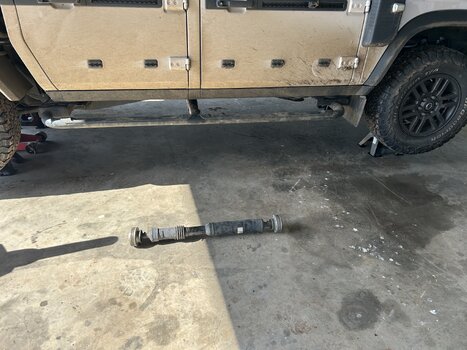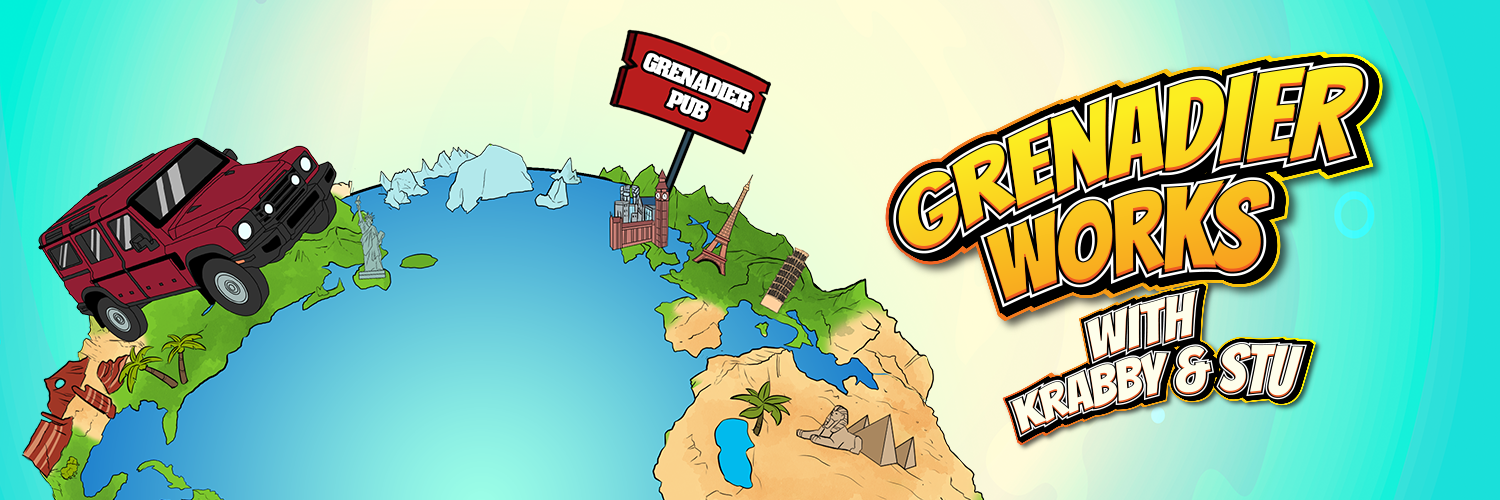Sure seems like a new design should be easy. But keep in mind this has been a problem for over a decade in Jeeps and some other vehicles. It's just that Jeep era just slapped in an $800 custom shaft and forgot about the problem.The path that I really wish someone would go down is designing or finding a better high speed Rzeppa boot. It isn't the joint that mechanically fails but rather the boot rips and spills the grease and then the joint fails from lack of lubrication or contamination or both. Here is a boot that certainly appears to be able to handle a more acute angle than the factory one.

High Speed CV Joint Boot Retainer 4.236" Diameter
Retainer only. High Speed CV Joint Boot Retainer 4.236" Diametermakodriveshafts.com
View attachment 7895374
The Grenadier Forum
Register a free account today to become a member! Once signed in, you'll be able to contribute to the community by adding your own topics, posts, and connect with other members through your own private inbox! INEOS Agents, Dealers or Commercial vendors please use the contact us link at the bottom of the page.
-
Guest submit your best shot for a chance to win the December Photo Contest. Photo Contest Click Here
You are using an out of date browser. It may not display this or other websites correctly.
You should upgrade or use an alternative browser.
You should upgrade or use an alternative browser.
Thanks for clearing that up for me, it is hard to keep up with all the info for sure on my end. So I'm good OEM until the boot fails then I should pucker up lol. For me if I lift means I need to replace joints to stop vibration every say 15k miles so be it, gotta pay to play. lol I just don't want it to grenade itself if possible.Ugh, I lost a long explanation of this and don't have the energy to retype. But, your stock Rzeppa shaft is good until the grease boot fails. The 3° deal is in regards to the proposed design from Agile. Their shaft simply exceeds the continuous operating limit by a fair bit. Not saying it won't work, it may or may not cause vibrations and may or may not fail in 20k miles or less. But your boot MAY fail in the same time frame. The new aftermarket Terra joints have been reliable so far with only one public report of a boot failure.
No worries. Luckily a failed boot does not mean instant disaster. From that point it's just a slow progression of failure.Thanks for clearing that up for me, it is hard to keep up with all the info for sure on my end. So I'm good OEM until the boot fails then I should pucker up lol. For me if I lift means I need to replace joints to stop vibration every say 15k miles so be it, gotta pay to play. lol I just don't want it to grenade itself if possible.
If you are just tooling around town or even off-road you may find the joint will be largely ok. It's doing 85mph down the highway that eats it up. At that point you should start to notice a light grinding sound. Nothing ominous, just a different sound that you haven't really noticed before. It will eventually get loud enough and clunky enough that you can ignore it and you will have at that point deduced that your boot has failed. This will happen over many hundreds of miles. At this point the joint may go on for another thousand or more miles depending on conditions and speed. And finally if you persist in neglecting the noise the shaft will eventually chew itself up enough to separate at the T-case and largely fall limp on the ground as it spins. The likely hood of massive flailing about is moderately low for a Rzeppa joint. A single Cardan or even worse a double Cardan can get to flailing about pretty bad and they tend to tear s$&t up in short order.
So yeah, take you pick of the poison at this point, but I suspect the Terra Rzeppas will do 10-15k before failure of the boot. Maybe much more if you drive 60mph or less most of the time. It's the heat of higher RPM that's getting them if not a pinch in the boot from lifting the truck without tending to the shaft first.
I wish I know what they didn't tilt the pinon up 5 degrees from the factory. It would have made a huge difference.View attachment 7895493Y'all don't take my word for it, research for yourself. This image shows the angle or slope of the front drive shaft on a 2" lifted Gren. The angle gauge was zeroed out on the pinion. So that means you have 13.2° at the pinion flange. The engine and trans is tilted in the truck a few degrees which makes the angle at the transfer case about 15° give or take. Our drive shafts are turning at about what, 3,500-4,000rpm at 80mph if I did my math right.
Longevity withstanding, the new shaft from Agile is problematic simply because the angle at each end of a single cardan shaft has to be nearly equal for it to run smoothly. Based on these measurements the difference is ~1.8° which will definitely cause vibrations somewhere in the RPM band.View attachment 7895493Y'all don't take my word for it, research for yourself. This image shows the angle or slope of the front drive shaft on a 2" lifted Gren. The angle gauge was zeroed out on the pinion. So that means you have 13.2° at the pinion flange. The engine and trans is tilted in the truck a few degrees which makes the angle at the transfer case about 15° give or take. Our drive shafts are turning at about what, 3,500-4,000rpm at 80mph if I did my math right.
Yep, all the difference in the world. Zero foresight on that one.I wish I know what they didn't tilt the pinon up 5 degrees from the factory. It would have made a huge difference.
Yep, probably right about 65mph I reckonLongevity withstanding, the new shaft from Agile is problematic simply because the angle at each end of a single cardan shaft has to be nearly equal for it to run smoothly. Based on these measurements the difference is ~1.8° which will definitely cause vibrations somewhere in the RPM band.
And it's off by 2.6° FYI. At least on my truck anyways.
With a 2.6° difference there would be a 100% chance of vibrations if using the Agile shaftYep, probably right about 65mph I reckon
And it's off by 2.6° FYI. At least on my truck anyways.
View attachment 7895567
The Agile shaft seems optimized for added durability off-road no doubt. That said, I would not use one on a daily driven vehicle seeing continuous running at freeway speeds. As others have noted, for single cardan joints to have any chance of running smooth both the transfer case and pinion flanges would need to be very close to the same angle to allow the joints to cancel each other out while rotating.
That’s not even considering the base static angles on the Grenadier already being toward the upper end of the spectrum of what a typical cardan should be running at for longevity. Their shaft most certainly will create some harmonics at higher speed ranges and will vary somewhat by vehicle so balance those pros & cons against what you think you’ll gain durability wise off-road.
For most folks a considerable amount of highway driving is involved getting your vehicle to a trail so it’s hard to say if this shaft offers any meaningful benefit over the long run if you are taking the life out of it at high speeds just getting to a trailhead?
That’s not even considering the base static angles on the Grenadier already being toward the upper end of the spectrum of what a typical cardan should be running at for longevity. Their shaft most certainly will create some harmonics at higher speed ranges and will vary somewhat by vehicle so balance those pros & cons against what you think you’ll gain durability wise off-road.
For most folks a considerable amount of highway driving is involved getting your vehicle to a trail so it’s hard to say if this shaft offers any meaningful benefit over the long run if you are taking the life out of it at high speeds just getting to a trailhead?
Having just joined the failed front shaft club, what are peoples opinions on some of these aftermarket shafts. Are they worth exploring, or am I better to just get the original fixed, and perhaps carry a spare cv?
And how far would you drive, front prop shaft out with centre diff locked in?
And how far would you drive, front prop shaft out with centre diff locked in?
Attachments
Last edited:
Deeply disappointing.... are you able to determine if it was a failed retention circlip?Having just joined the failed front shaft club, what are peoples opinions on some of these aftermarket shafts. Are they worth exploring, or am I better to just get the original fixed, and perhaps carry a spare cv?
And how far would you drive, front prop shaft out with centre diff locked in?
Didn’t look too deep to be honest. Had felt a worsening vibration under load for a few days, and an obvious clicking in reverse. Inspection revealed a ruptured boot. I thought I’d rip it out to check it in isolation.Deeply disappointing.... are you able to determine if it was a failed retention circlip?
I will have a closer look when i get back to the shed.
I also removed it as I thought it would be easier to send the shaft back to Brisbane than the entire vehicle (we’re about 5.5 hours away)
Is your car lifted or stock? If you use your car a lot for offroad, I suggest to change the factory one. The factory CV boots just cannot handle more articulation from the front axel.Having just joined the failed front shaft club, what are peoples opinions on some of these aftermarket shafts. Are they worth exploring, or am I better to just get the original fixed, and perhaps carry a spare cv?
And how far would you drive, front prop shaft out with centre diff locked in?
A small lift with the GVM increase - I think 35mm. Nearly all driving is on farm, so probably 80% dirt, but not a lot of technical stuff. Good advice though, I think I’ll look into some of the other options.Is your car lifted or stock? If you use your car a lot for offroad, I suggest to change the factory one. The factory CV boots just cannot handle more articulation from the front axel.
As with old rovers you can drive indefinitely in center lock.Having just joined the failed front shaft club, what are peoples opinions on some of these aftermarket shafts. Are they worth exploring, or am I better to just get the original fixed, and perhaps carry a spare cv?
And how far would you drive, front prop shaft out with centre diff locked in?
I would personally opt for just replacing the damaged CV itself. Here in the US the Terra Joint is cheap. If you can source them there then I would buy a spare or two as well.
You most likely only need to replace one joint and it's almost certainly the transfer case side. The diff side seems to hold up well.
I am curious if anyone has ever tried using back to back Rzeppa joints. I measured the joints on my Grenadier, and the double Cardan on a prototype front driveshaft. By using a male stub at the transfer case and front diff, placing a back to back Rzeppa joint assembly next then a slightly shorter shaft with similar to the original male stubs, surely some smart engineer could come up with a design. I was thinking that each male splined stub could have a drilling in the end. At each end of the shaft, one spline would have a stub with a ball, and the other a socket to capture the ball. Instead of having the sheet metal end cap on each Rzeppa joint, a short adapter is placed there, The ball and socket which ensures each Rzeppa joint flexes equally would run in the CV grease inside. The two Rzeppa joints would then be coupled by the ball and socket joint internally to ensure equal offset, and the centre adapter couples the two outer cases of the Rzeppa joints for the drive. This removes the vibration issues of universal joints entirely. If the ball and socket need to be able to move slightly during operation, maybe placing small springs inside each drilling in the male splined stubs to ensure the ball and socket are coupled would solve that problem.
It was inferred that using an aftermarket joint for a repair may void the driveline warranty, but this does seem the easiest way to get going.As with old rovers you can drive indefinitely in center lock.
I would personally opt for just replacing the damaged CV itself. Here in the US the Terra Joint is cheap. If you can source them there then I would buy a spare or two as well.
You most likely only need to replace one joint and it's almost certainly the transfer case side. The diff side seems to hold up well.
As an update, the ute is about to be loaded on a truck and carted off to Brisbane to be repaired, roughly 5.5 hours away. Now while I cannot fault the service of the dealership here (they’ve gone out of their way to facilitate this happening promptly), apparently INEOS insist this has to happen. Surely the logical solution is to take the shaft out here (as this is obviously the faulty part) and send that away to be repaired or replaced. It seems crazy to me that a company would insist on this procedure. To sell a vehicle that is designed to go off the beaten path, but then to require the whole vehicle be taken back to base for easily diagnosable issues just doesn’t make sense. particularly given the tiny service footprint that INEOS has relative to the size of the country geographically. I shudder to think of the cost of the process, when we are talking about a $500 cv joint. Again, I cannot fault the dealership or the Roadside Assist service, both have made the process quite easy. Nor am I upset about the time I have without the vehicle, I have others here that will suffice until it gets back. It’s the lack of flexibility and plain old common sense that worries me a bit.
I'm not inferring anything either, but you didn't share anything about the circumstances of the failure or any mods to your vehicle other than the spring lift and IA will need to assess that as part of a warranty claim. Whilst there is some history of driveshaft CV failures, your particular driveshaft failure might be a symptom of something else, including driver abuse. IA don't know what they can't see. Assessment aside, they may be collating data to understand more about the failure mode, like the castor angle on your front axle and the altered CV angle due to the lift. I can understand why they would want to get eyes on the vehicle. The driveshaft is just one part of a complex system.It was inferred that using an aftermarket joint for a repair may void the driveline warranty, but this does seem the easiest way to get going.
As an update, the ute is about to be loaded on a truck and carted off to Brisbane to be repaired, roughly 5.5 hours away. Now while I cannot fault the service of the dealership here (they’ve gone out of their way to facilitate this happening promptly), apparently INEOS insist this has to happen. Surely the logical solution is to take the shaft out here (as this is obviously the faulty part) and send that away to be repaired or replaced. It seems crazy to me that a company would insist on this procedure. To sell a vehicle that is designed to go off the beaten path, but then to require the whole vehicle be taken back to base for easily diagnosable issues just doesn’t make sense. particularly given the tiny service footprint that INEOS has relative to the size of the country geographically. I shudder to think of the cost of the process, when we are talking about a $500 cv joint. Again, I cannot fault the dealership or the Roadside Assist service, both have made the process quite easy. Nor am I upset about the time I have without the vehicle, I have others here that will suffice until it gets back. It’s the lack of flexibility and plain old common sense that worries me a bit.
Yep, all fair points. And while apart from adding a long range tank, everything is as it left the dealership, as you rightly say, they only have my word for that. I guess I figured that seeing as it’s a relatively established issue, the cheapest fix (for INEOS) is to get the part replaced and do the inspection side next time the vehicle is in for a service.I'm not inferring anything either, but you didn't share anything about the circumstances of the failure or any mods to your vehicle other than the spring lift and IA will need to assess that as part of a warranty claim. Whilst there is some history of driveshaft CV failures, your particular driveshaft failure might be a symptom of something else, including driver abuse. IA don't know what they can't see. Assessment aside, they may be collating data to understand more about the failure mode, like the castor angle on your front axle and the altered CV angle due to the lift. I can understand why they would want to get eyes on the vehicle. The driveshaft is just one part of a complex system.
Maybe I am just more annoyed than I’m letting myself think that I’ll be without it for a while, given how enjoyable it is to drive. I’d take it over these 79’s any day of the week!
Similar threads
- Replies
- 4
- Views
- 370
- Replies
- 6
- Views
- 920
- Replies
- 66
- Views
- 4K




